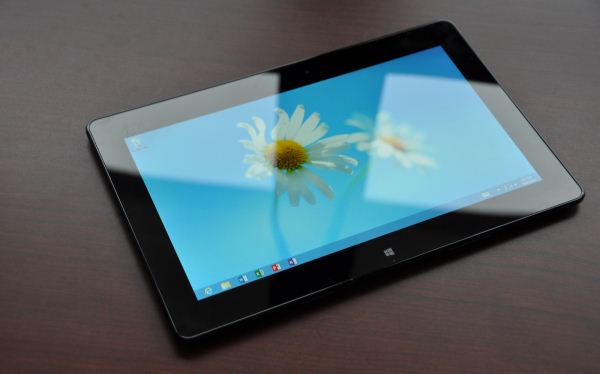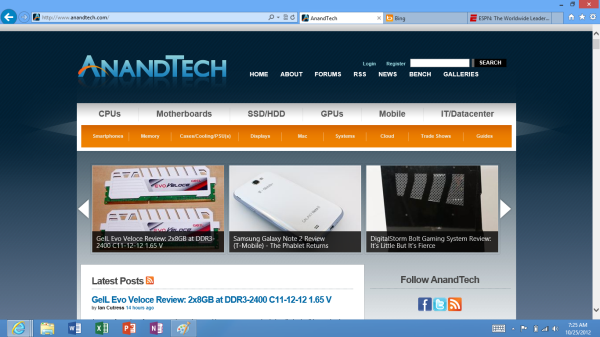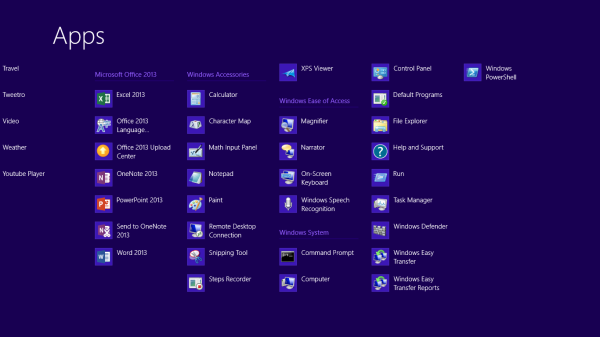The Windows RT Review
by Vivek Gowri & Anand Lal Shimpi on October 25, 2012 12:00 PM EST- Posted in
- Windows RT
- Operating Systems
- Microsoft
- Mobile
- Windows 8
- Tablets
Bridging the Gap, the Dichotomy of Windows RT
by Anand Shimpi
I described Windows RT as being a tablet OS with all of the underlying Windows-ness of Windows. You can get the big full screen app experience in tablet mode, but poke around your file system with Explorer or use Office 2013 like you would on a traditional notebook if you want to. If the two sides of Windows RT remained fairly separate that’d be one thing, unfortunately there are some dependencies between the two sides of the OS that keep the overall user experience from being as friendly as it is in iOS. There are still occasional reminders that you’re dealing with something that’s distinctly Windows here.
Most mobile OSes have done their best to hide the underlying file system and shell from the end user. Microsoft did, in my opinion, the smart thing and avoided hiding its roots with Windows RT. Although the new Start Screen is the default UI for Windows RT, there’s a big desktop tile front and center that will take you back to something far more familiar:
Unlike the Windows 8 desktop, you’re pretty limited in what you can do here. The only applications that are allowed to run in desktop mode under Windows RT are Explorer, IE10, Office 2013 and the command prompt (there are also all of the Windows specific tools and settings which I’ll get to shortly). Developers cannot make applications for Windows RT desktop mode and you can’t sideload anything here. Microsoft’s belief is that by completely locking down the system, requiring that applications only come from the Windows Store, it can avoid the pitfalls of viruses and malware that can plague Windows machines today.
Steve Sinofsky famously quoted an analyst when they asked if Windows RT would be backwards compatible with all of the legacy Windows viruses and spyware. The answer was an astounding no, and this is exactly why we can’t have open season on Windows RT desktop development. There’s also the obvious financial angle to all of this. Microsoft takes a cut of any apps sold through the Windows Store.
Coming from the perspective of a traditional Windows user, the lack of flexibility on the desktop seems wrong. From the perspective of the rest of the ARM based tablet space, it’s not a big deal. At least Windows RT gives you direct, first party access to the file system. There’s very little exposed through iOS, and with Android you need to download a third party app to get access to the file system.
Explorer works just as it would on a Windows 8 PC. The folder structure is exactly as you would expect it on any Windows machine. There are even some x86 remnants in the Windows RT install such as a C:\Windows\SysWOW64 directory complete with x86 binaries inside that obviously won’t run on your Windows RT tablet.
Internet Explorer in desktop mode works just like a traditional IE windows application would work. The desktop app actually controls settings and features for the Metro...err...fancy IE10. For example, if you want to change security settings, clear your history or empty your cache, you have to do all of these things from the IE10 desktop application. Fancy IE10 doesn’t expose them.
The command prompt is, well, a command prompt. It features all of the same commands that you could run before, although once again you can’t simply drop an x86 exe on your system and run it. Not having binary compatibility can be frustrating at times.
Although developers can’t build applications for Windows RT’s desktop, you can write and execute batch files. Keep in mind that if your batch file needs any additional support files (e.g. sleep.exe) you’ll need ARM versions of them which, unless they come from Microsoft, just isn’t happening.
As I mentioned earlier, there are a few other things you can run and do in RT’s desktop mode. Control Panel, event viewer, disk management and all of the other administrative tools that you’d expect to come with Windows are present in Windows RT (including regedit). There are also the little apps that Microsoft has always included, which also work in desktop mode (e.g. mspaint, calc, notepad, etc...)
Ultimately Windows RT is an ARM version of Windows with tablet makeup on. You still get all of the normal bits and pieces of Windows, minus some flexibility and of course, backwards compatibility.
For years we’ve been asking Microsoft to make a clean break with its legacy code and introduce a version of Windows that was built from scratch, with only support for the latest hardware. With Windows RT, Microsoft finally delivered some of that, but in a sort of weird, backwards way.
As Windows RT only supports the ARMv7 instruction set architecture, none of your old x86 applications will run on the platform. Microsoft hoped to avoid this being a problem by shipping an ARM version of Office 2013 Home & Student Edition with Windows RT tablets, and by directing users at the Windows Store for the rest of their application needs. Although it would’ve been possible for Microsoft to enable x86 compatibility through emulation or binary translation, performance would’ve likely been pretty bad.
The loss of backwards compatibility with years of Windows applications feels wrong, but from Microsoft's perspective you don't get that with iOS and Android so there's no real competitive disadvantage here. Why bother with an ARM based version of Windows to begin with? To bring competition to Intel and ensure that it will be able to deliver Windows to the new wave of ultra mobile devices (e.g. tablets). Intel hasn't been competitive on power or pricing at the low end (read: Atom) of the spectrum for years now. The introduction of Windows RT changed that. Atom Z2760 (Clovertrail) is around half the price of the cheapest Atom CPU of the past five years, and it's price competitive with solutions from Qualcomm. We have Windows RT to thank for that. Without pressure from ARM, Clovertrail would've started around $50 per chip just like Intel's low end parts had in the past. As AMD is no longer a pricing check for Intel in some of these new markets, Microsoft had to look for a new way to offer balance. Supporting ARM is its way of doing that. Until there's a new pricing/power/performance x86 competitor to Intel in tablets, ARM and Windows RT will remain.














233 Comments
View All Comments
steven75 - Friday, November 2, 2012 - link
You are either truly delusional or have no idea the limitations of RT.-It can't join a domain.
-Office is the student/home edition. No Macros, no plugins, etc.
-95% of the fortune 500 has already deployed iPads.
chavv - Friday, October 26, 2012 - link
so, the only "real" browser will be IE10?And what about support for card readers/certificates?
Can one use certificates to sign documents?
thesavvymage - Friday, October 26, 2012 - link
Really REALLY hope the folks over at VLC or many of the android video players get an app onto windows RT for mkv playback! Almost any anime is in this format with advanced subtitles, and itd be absolutely amazing to have this tablet on my daily university bus commute if it supported those video files :)Pressurge - Friday, October 26, 2012 - link
that the review for the yearly refresh of iOS got a much greater, in-depth review than the first-ever version of Windows running on ARM, including the fact that it's on a Microsoft-designed/spec'd tablet. "Hey, let's do three pages worth of review just on the new Maps app, but nothing in Windows RT deserves that type of in-depth analysis at all!"There appears to be no end in sight to the massive time investment towards all things Apple on Anandtech while everything else gets filler articles/reviews at best...
Che - Sunday, October 28, 2012 - link
+1hakime - Friday, October 26, 2012 - link
"It’s unclear how big this convertible/hybrid market will grow, but I see real potential here."Keep dreaming.....
"The iPad and iOS remain a very polished, very accessible platform that is really optimized for content consumption and light productivity. For anyone who wanted more however, there’s now an alternative: Windows RT."
"The default inclusion of Office 2013 and the emphasis on physical keyboards makes Windows RT the first tablet platform to significantly address the question of productivity."
Reading this review, it strikes me that people at Anandtech either are totally biased towards Windows (which wouldn't be new, see also the Surface review) or they've never used an iPad. I put my money on the first one. Because you can't possibly claim that the iPad is less productive than a tablet with Windows RT, you really can't unless your are out of your mind.
There is nothing that makes Windows RT more productive than iOS because you seem to have missed that it's iOS which has the productive apps today. Windows RT has nothing, nothing, and it will stay like that for a long time. If you want to be productive with a tablet today, you get an iPad not a tablet with Windows RT, period. iOS has productive apps that cover everything from video, audio production to art, photo workflows and text editors, CAD, etc.. All of them are optimized for touch. With Windows RT, to be productive you just get Office that you really can't use freely because of the restricted license. Office forces you to use a keyboard attached to a tablet and because such keyboards are very limited, you can't really use it with an attached keyboard either. What a mess.....
"Combined with the equally advanced task switching and multitasking built into the UI, and this becomes the first legitimately useful tablet operating system out there."
Then you are really not making sense, it's amazing. The multitasking on Windows RT is nothing better than iOS, it actually works the same way. The only thing is that it allows to put a stripped down app besides another one but this feature is not very useful on tablet screens. And this feature only exists because Windows RT has a fundamental flaw that this review completely ignores. Windows RT forces you to use a tablet in landscape mode (hence more room for the Snap feature) but at the price of sacrificing tremendously the usability of the system when used as a tablet (a shame when the system is supposed to be for tablets) because it's difficult to use the tablet in this mode without any attached keyboard. And by itself, Windows RT is more designed for consumption than being useful for production because of the choice of this landscape mode as default mode and also because the "Metro" interface is designed to be eye candy and only makes sense for content consumption apps. The interface is actually rather limited and constraining when it comes to have freedom in building any type of apps. So claiming that Windows RT is the first legitimately useful tablet operating system out there is at the limit of being a total troll who is disconnected from the reality. In the real world today, Windows RT is the less useful tablet OS out there not only because it lacks apps, but also it's design does everything in order that this OS is limited to content consumption.
"Every single Windows RT slate comes out of the box with Office and the ability to have multiple active application windows. It’s just a few steps ahead of competing tablet platforms at this point."
Again Office is not very useful on Windows RT, its useless in touch mode, hard to use with those Type Covers or whatever else, so it's just bad... There is absolutely not advantage over competing platforms here, absolutely none...
"From a conceptual standpoint, almost anything you can do with an iPad can be done equally well (or close) on a Windows RT tablet"
No it can't because it lacks apps and polish. The metro interface is too confusing, too busy, actually too much eye candy in order to hide the reality of an OS which is technically behind. I am amazed to see that the authors did not really point out the incredible deficiencies of the built-in apps. Mail, Messaging, Calendar lacks basic features to the point of being useless, IE 10 is buggy like the rest of the OS which often feels sluggish and lacks stability. I mean a dude in the iPhone 5 review came up with some completely baseless, unreal theory of scuffs affecting the iPhone 5, describing in length a completely baseless theory of an iPhone 5 production that the author in fact had not idea of. Like often in Anandtech and when it's about Apple, the authors go in lengthy baseless analysis that they don't have the real competence to do, but they do it anyway just to appear smarter than they are in reality. So we've got an iPhone 5 review where we were still being told about the AntennaGate, something that never existed and now also about a new Scuffgate which also does not have any real existence besides being some minor manufacturing issues on some units. Today, we've got a flawed software from Microsoft, I mean Microsoft sells you a half featured Mail app and buggy software but no word on that from the authors, no words on whatever gate. The authors of Anandtech really lacks honesty, you've got to get your ch.. together guys, really!!
"but the desktop-caliber office suite and versatile multitasking interface of Windows RT are impossible experiences to replicate on the iPad"
Oh yes sure because the iPad is not trying to run a desktop app on a touch devise. Yes indeed!!! Did you really use Office on Windows RT, honestly, say the truth? Office is unusable with fingers, it requires an atached keyboard which also is crap and comes with a completely, insanely bad trackpad. Please explain how this is supposed to be an experience that the iPad should replicate? On the other hand, iWork on iPad is a desktop caliber suite which is designed to work with touch. Which one you use?
You keep speaking about this multitasking thing like you are really trying hard to find something to like in Windows RT. The reality is that the multitasking on Windows RT works like iOS with extra poorly implemented features most of the time not very useful on a tablet screen and which forced a design decision that really messes up the ease of use of Windows RT as a tablet OS.
"if you’re looking for a new tablet this fall, Windows RT deserves your consideration. "
Yes sure, if you want a buggy OS, designed towards content consumption, with limited and buggy built-in apps and no apps to use besides them, sure go ahead....
maximumGPU - Friday, October 26, 2012 - link
I always find it funny that the same person (Anand) can be accused of being both an apple fanboy and a microsoft fanboy in different articles, and sometime in the same one. This just shows you that it's only commentators like you who are one.You're (extremely boring) reply has nothing of substance except personnal opinions and baseless attacks.
i have owned every ipad (and still own the 3rd one), and i agree with the article in that productivity is limited on these tablets.
maximumGPU - Friday, October 26, 2012 - link
Oh there it is, check a few posts down and the user "milkod2001" calling Anand an apple fanboy...ludikraut - Friday, October 26, 2012 - link
but which world are you living in? Seriously."...Reading this review, it strikes me that people at Anandtech either are totally biased towards Windows (which wouldn't be new, see also the Surface review) or they've never used an iPad. I put my money on the first one. Because you can't possibly claim that the iPad is less productive than a tablet with Windows RT, you really can't unless your are out of your mind...."
The only one out of their mind is you. Have you actually used Windows RT - or even Windows 8 - on a tablet? Didn't think so.
"...There is nothing that makes Windows RT more productive than iOS because you seem to have missed that it's iOS which has the productive apps today..."
I think you're confusing productivity with productive.
"...Then you are really not making sense, it's amazing. The multitasking on Windows RT is nothing better than iOS, it actually works the same way. The only thing is that it allows to put a stripped down app besides another one but this feature is not very useful on tablet screens..."
And here you manage to contradict yourself in the span of two sentences. I won't bother to pick apart the rest of the post, I'd be here all day. Next time ... think before posting and check your facts ... please?
l8r)
steven75 - Friday, November 2, 2012 - link
Have you ever used an iPad? Have you used the iWorks apps on one? Do you realize a keyboard not only works with an iPad but is not a totally necessity unlike with Office on Windows RT?I am in complete agreement the reviewer doesn't have any experience with iPad productivity apps or is living a life completely shacked to Microsoft Office.